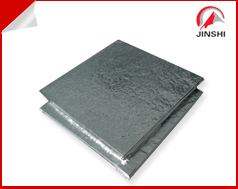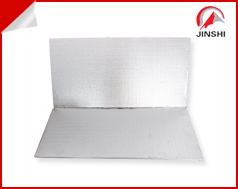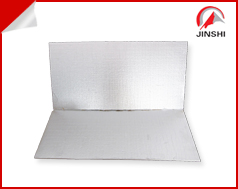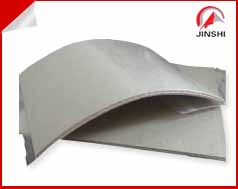The current position:
NEWS >
Industry News >
Calculation of economic benefits of application of nanoporous thermal insulation materials
Calculation of economic benefits of application of nanoporous thermal insulation materials
Economic benefit calculation of nano heat insulation board application
1. theoretical formula derivation of ladle heat dissipation
The application of nano heat insulation board reduced the surface temperature of 210 tons ladle from 310 ℃ to 220 ℃. The ladle is considered as a heat source with constant surface temperature and heat dissipation, and the difference of heat dissipation between the heat sources at different surface temperatures is investigated separately. That is to say, the ladle and the molten steel loaded in the ladle are considered as a whole object, because the ladle filled with the molten steel has much more heat than the surface heat dissipation amount, the internal temperature of the ladle is far higher than the ambient temperature, and the external surface of the ladle has no forced cooling medium, the ladle can be regarded as a cylinder with constant surface temperature, and the heat dissipation amount is independent of the temperature of the molten steel contained in the ladle, and is only related to factors such as the surface temperature of the ladle, environmental conditions and the like.
According to the theory of heat transfer, the heat dissipation loss of ladle is mainly composed of natural convection heat dissipation and radiation heat dissipation. The space surface area of the workshop is much larger than the surface area of the ladle, and the volume of the workshop is much larger than the volume of the ladle. from the above analysis, it can be considered that the heat dissipation process of the ladle can be simplified as follows: a vertical cylinder with constant surface temperature carries out radiation heat transfer and natural convection heat transfer in an infinite space. The calculation of that heat transfer proces is established by model based on the simplification described above.
The heat work φ = φ 1 + φ 2 of the ladle heat transfer loss, where φ 1 - ladle radiation heat transfer, φ 2 - ladle convection heat transfer. According to the calculation formula of radiant heat flux of the object ( Boltzmann formula )
φ 1 = ξ a σ ( t1 4 - T2 4 ) ( unit: w ), where:
Tl - ladle surface temperature in k
T2 - ambient temperature in k
ξ - blackness, can be considered to be 1
σ - Boltzmann constant, with a value of 5.67 xlo - 8 w / ( m2 k 4 )
A - ladle surface area, m 2
Φ 2 can be considered as convection heat transfer of vertical cylinder, applicable to the following convection heat transfer formula
φ 2 = ah △ t ( unit: w ), where: h - surface heat transfer coefficient. a - heat transfer surface area, △ t - temperature difference between cylindrical surface temperature and ambient temperature
H = nu lambda / I, where nu - Nusselt number, lambda - thermal conductivity, I - qualitative dimensions, where cylinder height is used
Nu = c ( grpr ) n, where gr - grachev number, pr - prandtl number, c, n - constant
Gr = ga △ ti 3 / v 2 where: g - gravitational acceleration, a - volumetric expansion coefficient, v - kinematic viscosity
2. calculation results and analysis
Since the heat dissipation on the surface of the ladle is independent of its three-dimensional configuration and is only related to the surface area, the ladle can be considered as a cylinder. the average diameter of the ladle is known to be 3761 mm, the height is 1 = 4.46 m, and the surface area a of the ladle is calculated to be 52.65 m 2,
From that analysis of the first part, it can be seen that the heat work φ comparison and φ t of the heat dissipation loss of the comparative ladle and the experimental ladle can be calculate by substituting the known conditions into the above heat transfer formulas for the temperature t1 of the outer wall of the ladle before and aft the application of the heat insulation plate to 310 deg c and 220 deg c respectively,
Phi comparison = 2.47 x 106w, phi test = l.55xl 0 6w
Phi contrast - phi test = △ phi = 0.92 xl0 6w
And heat dissipation q = Φ t, t - ladle running time, check the specific heat CP of molten steel at 1600 ℃ to 1700 ℃ is 0.837 KL / kg, assuming that the total mass of molten steel is, then at the outer wall of the ladle temperature 310 ℃ and 220 ℃ of the heat dissipation difference delta Φ can make the whole molten steel temperature delta t = q / MCP = Φ t / MCP, this t is a function of m and, in the case of molten steel quality is certain, only related to turnover time T..
Assuming an average mass of 210 t of molten steel, △ t = 0.00523 t,
3, statistical analysis, the average turnover time of steel ladle is about 100 minutes, which can be concluded that the temperature loss of molten steel is; Delta t = 0.00523 * 6000 = 31.38 ℃
Application difficulty
Because the main raw material of the microporous thermal insulation material is amorphous silicon dioxide, the thermal stability of the microporous thermal insulation material is not as good as that of refractory bricks or some high-grade ceramic fibers, and the long-term service temperatures of nif - 1050 and nif - 1100 nano microporous thermal insulation felt are 1000 deg c and 1050 deg c, and when the service temperature is exceeded, the shrinkage rate of the material is increased, so that potential safety hazards are brought.
Therefore, it is necessary to calculate the temperature distribution according to the thermal conductivity of each layer of materials when designing the thickness of the refractory layer and the thermal insulation layer, so as to ensure that the temperature of the nanoporous thermal insulation board does not exceed the specified long-term service temperature. Summary
With the development of application technology, nano thermal insulation panels are gradually applied in steel mills at home and abroad, and the effectiveness of the material in energy conservation and emission reduction is further recognized. The initial cost of the nano heat insulation board is increased to a certain extent, and the energy consumption is saved more than the investment cost in the steel metallurgy manufacturing process; meanwhile, the heat loss in the steel production process can be accurately controlled, so that the optimal utilization efficiency of the energy and the energy conservation can be ensured, and the pollution to the environment can be minimized.
1. theoretical formula derivation of ladle heat dissipation
The application of nano heat insulation board reduced the surface temperature of 210 tons ladle from 310 ℃ to 220 ℃. The ladle is considered as a heat source with constant surface temperature and heat dissipation, and the difference of heat dissipation between the heat sources at different surface temperatures is investigated separately. That is to say, the ladle and the molten steel loaded in the ladle are considered as a whole object, because the ladle filled with the molten steel has much more heat than the surface heat dissipation amount, the internal temperature of the ladle is far higher than the ambient temperature, and the external surface of the ladle has no forced cooling medium, the ladle can be regarded as a cylinder with constant surface temperature, and the heat dissipation amount is independent of the temperature of the molten steel contained in the ladle, and is only related to factors such as the surface temperature of the ladle, environmental conditions and the like.
According to the theory of heat transfer, the heat dissipation loss of ladle is mainly composed of natural convection heat dissipation and radiation heat dissipation. The space surface area of the workshop is much larger than the surface area of the ladle, and the volume of the workshop is much larger than the volume of the ladle. from the above analysis, it can be considered that the heat dissipation process of the ladle can be simplified as follows: a vertical cylinder with constant surface temperature carries out radiation heat transfer and natural convection heat transfer in an infinite space. The calculation of that heat transfer proces is established by model based on the simplification described above.
The heat work φ = φ 1 + φ 2 of the ladle heat transfer loss, where φ 1 - ladle radiation heat transfer, φ 2 - ladle convection heat transfer. According to the calculation formula of radiant heat flux of the object ( Boltzmann formula )
φ 1 = ξ a σ ( t1 4 - T2 4 ) ( unit: w ), where:
Tl - ladle surface temperature in k
T2 - ambient temperature in k
ξ - blackness, can be considered to be 1
σ - Boltzmann constant, with a value of 5.67 xlo - 8 w / ( m2 k 4 )
A - ladle surface area, m 2
Φ 2 can be considered as convection heat transfer of vertical cylinder, applicable to the following convection heat transfer formula
φ 2 = ah △ t ( unit: w ), where: h - surface heat transfer coefficient. a - heat transfer surface area, △ t - temperature difference between cylindrical surface temperature and ambient temperature
H = nu lambda / I, where nu - Nusselt number, lambda - thermal conductivity, I - qualitative dimensions, where cylinder height is used
Nu = c ( grpr ) n, where gr - grachev number, pr - prandtl number, c, n - constant
Gr = ga △ ti 3 / v 2 where: g - gravitational acceleration, a - volumetric expansion coefficient, v - kinematic viscosity
2. calculation results and analysis
Since the heat dissipation on the surface of the ladle is independent of its three-dimensional configuration and is only related to the surface area, the ladle can be considered as a cylinder. the average diameter of the ladle is known to be 3761 mm, the height is 1 = 4.46 m, and the surface area a of the ladle is calculated to be 52.65 m 2,
From that analysis of the first part, it can be seen that the heat work φ comparison and φ t of the heat dissipation loss of the comparative ladle and the experimental ladle can be calculate by substituting the known conditions into the above heat transfer formulas for the temperature t1 of the outer wall of the ladle before and aft the application of the heat insulation plate to 310 deg c and 220 deg c respectively,
Phi comparison = 2.47 x 106w, phi test = l.55xl 0 6w
Phi contrast - phi test = △ phi = 0.92 xl0 6w
And heat dissipation q = Φ t, t - ladle running time, check the specific heat CP of molten steel at 1600 ℃ to 1700 ℃ is 0.837 KL / kg, assuming that the total mass of molten steel is, then at the outer wall of the ladle temperature 310 ℃ and 220 ℃ of the heat dissipation difference delta Φ can make the whole molten steel temperature delta t = q / MCP = Φ t / MCP, this t is a function of m and, in the case of molten steel quality is certain, only related to turnover time T..
Assuming an average mass of 210 t of molten steel, △ t = 0.00523 t,
3, statistical analysis, the average turnover time of steel ladle is about 100 minutes, which can be concluded that the temperature loss of molten steel is; Delta t = 0.00523 * 6000 = 31.38 ℃
Application difficulty
Because the main raw material of the microporous thermal insulation material is amorphous silicon dioxide, the thermal stability of the microporous thermal insulation material is not as good as that of refractory bricks or some high-grade ceramic fibers, and the long-term service temperatures of nif - 1050 and nif - 1100 nano microporous thermal insulation felt are 1000 deg c and 1050 deg c, and when the service temperature is exceeded, the shrinkage rate of the material is increased, so that potential safety hazards are brought.
Therefore, it is necessary to calculate the temperature distribution according to the thermal conductivity of each layer of materials when designing the thickness of the refractory layer and the thermal insulation layer, so as to ensure that the temperature of the nanoporous thermal insulation board does not exceed the specified long-term service temperature. Summary
With the development of application technology, nano thermal insulation panels are gradually applied in steel mills at home and abroad, and the effectiveness of the material in energy conservation and emission reduction is further recognized. The initial cost of the nano heat insulation board is increased to a certain extent, and the energy consumption is saved more than the investment cost in the steel metallurgy manufacturing process; meanwhile, the heat loss in the steel production process can be accurately controlled, so that the optimal utilization efficiency of the energy and the energy conservation can be ensured, and the pollution to the environment can be minimized.
The next article:It's the last one In the previous:Annual output 4000 tons of nano aerogel insulation felt production line
Rankings of similar articles
- Annual output 4000 tons of nano aerogel insulation felt production line
- Characteristics of nano aerogel thermal insulation felt aerogel
- Application analysis of nano heat insulation board in steel ladle
- Application example of nano aerogel insulation felt
- Why is the thermal insulation effect of nano thermal insulation board so good
- Preparation of nano aerogel insulation felt
- Tangshan medium and heavy plate co., ltd approved the heat preservation effect after using nano heat insulation board.
- Why use nano heat shield in steelmaking process
Latest information
- Recruitment (Domestic Sales, E-Commerce)
- Italian customers come to visit our company and reach in-depth cooperation
- JinShi participate in 2016 international wall roofing materials production and equipment Expo
- Six Excellent Properties of Nano Aerogel Insulation Felt
- Nano Aerogel Insulation Felt is known as
- Comparison of thermal insulation effect of nano aerogel thermal insulation felt and other thermal insulation materials in petroleum pipeline
- The nano aerogel thermal insulation felt has good thermal insulation performance, superhydrophobic property, long service life, compression resistance and easy installation and maintenance
- Why not many manufacturers of nano aerogel insulation felt on the market?
- Characteristics and preparation process of nano aerogel insulation felt
- Can nano heat shields be used on ships and vessels and how?
Contact us

hotline:
86-132-806-65866
The phone:86-0533-2266502
add:Shandong zibo hi-tech development zone.






